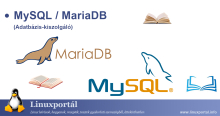Content
Overview
MySQL is an open source relational database management system. It is named after a combination of "My", the daughter of co-founder Michael Widenius, and "SQL", an acronym for Structured Query Language. The MySQL development project makes the source code available under the terms of the GNU General Public License and a number of different agreements. MySQL was originally owned by the Swedish company MySQL AB, acquired by SUN in 2008 and acquired by Oracle Corporation in 2010. Thus, the software is now owned by Oracle.
MySQL is a central component of the open source web application software package, LAMP, and other "AMP" packages (WAMP, XAMPP). LAMP stands for "Linux, Apache, MySQL, PHP". Many web applications use MySQL, such as Drupal, Joomla, WordPress, phpBB, MyBB, etc., as well as larger websites such as Facebook, Twitter, YouTube, Flickr, and so on.
The software is written in C and C ++, and the SQL shell is in the yacc programming language. MySQL runs on a variety of system platforms including FreeBSD, Linux, macOS, Microsoft Windows, NetBSD, Novell NetWare, OpenBSD, OpenSolaris, OS / 2, Oracle Solaris, Symbian, SunOS.
Database management is available through custom APIs in many programming languages such as C, C ++, C #, Delphi, Java, Perl, PHP, Python, Ruby, Tcl, etc.
MySQL is also used on cloud-based platforms such as Microsoft Azure, Amazon EC2, Oracle Cloud Infrastructure.
User interfaces
MySQL can be administered through a variety of graphical user interfaces, including:
- MySQL Workbench (Official interface released by database software developers)
- phpMyAdmin (The well-known web database interface)
- Navicat
- Webmin
- Adminer: Interface formerly known as phpMinAdmin
- ClusterControl
- Database Workbench
- DBeaver
- DBEdit
- HeidiSQL
- LibreOffice Base
- SQLBuddy
In addition, there is a command line interface where you can directly issue SQL statements. The surface a mysql by running a command.
abilities
Database management software has become popular with its extensive capabilities. Some of these are:
- Stored Procedures
- Database triggers
- "View" databases (views)
- Cross-platform availability
- Genuine VARCHAR support
- INFORMATION_SCHEMA support
- "Strict" mode
- Multiple storage engine support (eg: MyISAM, InnoDB)
- Manage transactions with InnoDB, BDB and Cluster storage engines
- SSL aid
- Query caching
- Nested SELECT commands
- Fulltext indexing with the MyISAM engine
MariaDB
Under the leadership of the original MySQL developers, a new software branch, MariaDB, has been developed on a community basis, expanding the capabilities of the original software suite, based on MySQL and remaining licensed under the GNU GPL. MariaDB aims to maintain a high degree of compatibility with MySQL so that it can be easily replaced. MariaDB supports several new storage engines over MySQL.
MariaDB is becoming more and more widespread in various Linux distributions, where the distributions already include the MariaDB database manager by default.
- 373 views

